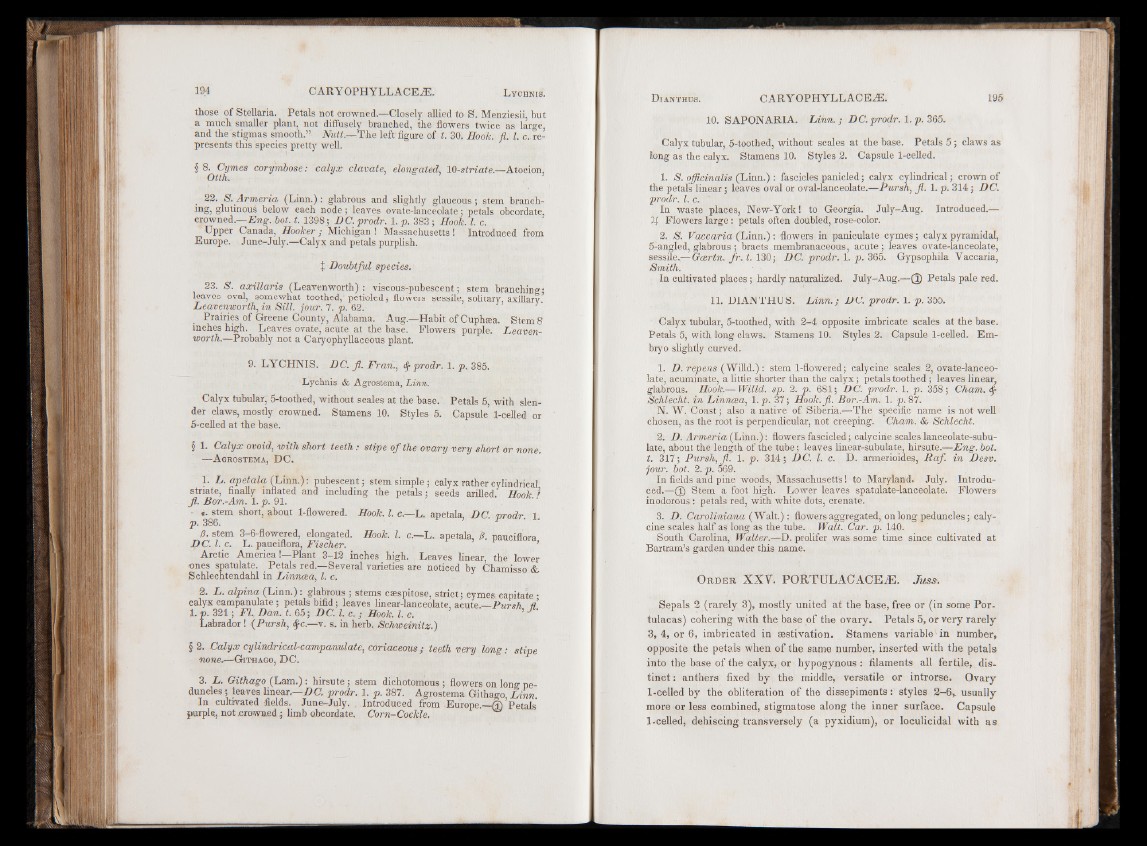
those of Stellaria. Petals not crowned.—Closely allied to S. Menziesii, but
a much smaller plant, not diffusely branched, the flowers twice as large,
and the stigmas smooth.” Nutt.—The left figure of t. 30. Hook. fl. 1. c. represents
this species pretty well.
§ 8. Cymes corymbose: calyx clavate, elongated, 10-striate.—Atocion,
Otth.
22. S. Armeria (Linn.): glabrous and slightly glaucous; stem branching,
glutinous below each node; leaves ovate-lanceolate; petals ohcordate,
crowned.—E n g . hot. t. 1398; DC. prodr. 1. p. 383; Hook. 1. c.
Upper Canada, Hooker; Michigan ! Massachusetts ! Introduced from
Europe. June-July.—Calyx and petals purplish.
I Doubtful species.
23. S. axillaris (Leavenworth): viscous-pubescent; stem branching;
leaves oval, somewhat toothed, petioled; flowers sessile, solitary, axillary ’
Leavenworth, in Sill. jour. 7. p. 62.
Prairies of Greene County, Alabama. Aug.—Habit of Cuphtea. Stem 8
inches high. Leaves ovate, acute at the base. Flowers purple. Leavenworth.—
Probably not a Caryophyllaceous plant.
9. LYCHNIS. DC. fl. Fran., dj- prodr. 1. p. 385.
Lychnis & Agrostema, Linn.
Calyx tubular, 5-toothed, without scales at the base.' Petals 5, with slender
claws, mostly crowned. Stamens 10. Styles 5. Capsule 1-celled or
5-celled at the base.
§ 1. Calyx ovoid, with short teeth: stipe o f the ovary very short or none.
—A g r o s t e m a , DC.
1. L. apetala (Linn.): pubescent; stem simple ; calyx rather cylindrical
striate, finally inflated and including the petals; seeds arilled. Hook '
fl. Bor.-Am. 1. p. 91.
*■ stem short, about 1-flowered. Hook. 1. c.—L. apetala, DC. prodr. 1.
p. 386.
0. stem 3-6-flowered, elongated. Hook. 1. c.—L. apetala, 0. pauciflora
DC. 1. c. L. pauciflora, Fischer.
Arctic America!—Plant 3-12 inches high. Leaves linear, the lower
ones spatulate. Petals red.—Several varieties are noticed by Chamisso &
Schlechtendahl in Linncea, l. c.
2. L. alpina (Linn.) : glabrous ; stems caespitose, strict; cymes capitate *
calyx campanulate; petals bifid ; leaves linear-lanceolate, acute —Pursh
1. p. 321; Fl., Dan. t. 65; DC. 1. c .; Hook. 1. c. ’ >
Labrador! {Pursh, $c.—v. s. in herb. Schweinitz.)
§ 2. Calyx cylindrical-campanulate, coriaceous; teeth very long: stipe
Mo»e.—G it h a g o , DC.
3. L. Githago (Lam.) : hirsute ; stem dichotomous ; flowers on long peduncles;
leaves linear.—DC. prodr. 1. p. 387. Agrostema Githago, Linn.
In cultivated fields. June-July. , Introduced from Europe.__ffi Petals
purple, not crowned.; limb abcordate. Corn-Cockle. ’ ^
10. SAPONARIA. Linn.; DC. prodr. 1. p. 365.
Calyx tubular, 5-toothed, without scales at the base. Petals 5; claws as
long as the calyx. Stamens 10. Styles 2. Capsule 1-celled.
1. S. officinalis (Linn.) : fascicles panicled; calyx cylindrical; crown of
the petals linear; leaves oval or oval-lanceolate.—Pursh, fl. 1. p. 314 ; DC.
prodr. 1. c.
In waste places, New-York! to Georgia. July-Aug. Introduced.—
K Flowers large: petals often doubled, rose-color.
2. S. Vaccaria (Linn.): flowers in paniculate cymes; calyx pyramidal,
5-angled, glabrous ; bracts membranaceous, acute; leaves ovate-lanceolate,
sessile.;— Gcertn. fir. t. 130; DC. prodr. 1. p. 365. Gypsophila Vaccaria,
Smith.
In cultivated places; hardly naturalized. July-Aug.—(D Petals pale red.
11. DIANTHUS. L in n .; DC. prodr. 1. p. 355.
Calyx tubular, 5-toothed, with 2-4 opposite imbricate scales at the base.
Petals 5, with long claws.. Stamens 10. Styles 2. Capsule 1-celled. Embryo
slightly curved.
1. D. repens (Willd.) : stem 1-flowered; calycine scales 2, ovate-lanceolate,
acuminate, a little shorter than the calyx; petals toothed; leaves linear,
glabrous. Hook,.^ Willd. sp. 2. p. 681; DC. prodr. 1. p. 358; Cham. $
Schlecht. in Linncea, l.p . 37; Haok.fl. Bor.-Am. 1. p. 87.
N. W. Coast; also a native of Siberia.—The specific name is not well
chosen, as the root is perpendicular, not creeping. Cham. & Schlecht.
2. D. Armeria (Linn,): flowers fascicled; calycine scales lanceolate-subulate,
about the length of the tube; leaves linear-subulate, hirsute.—Eng. bot.
t. 317; Pursh, fl. 1. p. 314; DC. 1. c. D. armerioides, Rafi in Desv.
jour. bot. 2. p. 569.
In fields and pine woods, Massachusetts! to Maryland. July. Introdu-
c ed g -® Stem a foot high. Lower leaves spatulate-lanceolate. Flowers
inodorous : petals red, with white dots, crenate.
3. D. Caroliniana (Walt.) : flowers aggregated, on long peduncles; calycine
scales half as long as the tube. Walt. Car. p. 140.
South Carolina, Walter.—D. prolifer was some time since cultivated at
Bartram’s garden under this name.
Or d e r XXV. PO R TU LA C A C E iE . Juss.
Sepals 2 (rarely 3), mostly united at the base, free or (in some Por-
tulacas) cohering with the base o f the ovary. Petals 5, o rrery rarely
3, 4, or 6 , imbricated in aestivation. Stamens variable'in number,
opposite the petals when o f the same number, inserted with the petals
into the base of the calyx, or hypogynous : filaments all fertile, distinct
: anthers fixed by the middle, versatile or introrse. Ovary
1-celled by the obliteration o f the dissepiments: styles 2—6» usually
more or less combined, stigmatose along the inner surface. Capsule
1-celled, dehiscing transversely (a pyxidium), or loculicidal with as